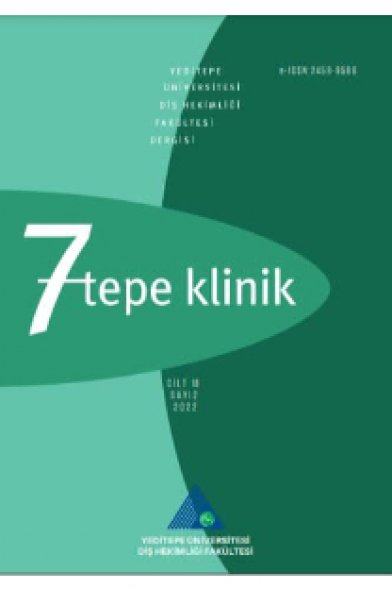OSC-19 hücre hattı kullanımı ile ksenograft oral yassı hücreli karsinoma fare modelinin geliştirilmesi
Development of xenograft oral squamous cell carcinoma mouse model
___
- Attar E, Dey S, Hablas A, Seifeldin IA, Ramadan M, et al. Head and neck cancer in a developing country: a population-based perspective across 8 years. Oral Oncol. 2010;46(8):591-596.
- Bagan J, Sarrion G, Jimenez Y. Oral cancer: clinical features. Oral Oncol. 2010;46(6):414-417.
- Zhang J, Gao F, Yang AK, Chen WK, Chen SW, et al. Epidemiologic characteristics of oral cancer: single-center analysis of 4097 patients from the Sun Yat-sen University Cancer Center. Chinese Journal of Cancer 2016; 35, 24.
- Ng JH, Iyer NG, Tan MH, Edgren G. Changing epidemiology of oral squamous cell carcinoma of the tongue: a global study. Journal of The Sciences and Specialties of The Head and Neck 2017; 39: 297-304.
- Park GC, Roh JL, Cho KJ, Kim JS, Jin MH, et al. F-FDG PET/CT vs human Papillomavirus, p16 and Epstein-Barr virüs detection in cervical metastatic lymph nodes for identifing primary tumors. International Journal of Cancer 2017, 140(615),1405-1412.
- Yom SS. HPV and oropharyngeal cancer: etiology and prognostic importance. Seminars in cutaneous medicine and surgery 2015; 34(4): 178-181.
- Macey R, Walsh T, Brocklehurst P, Kerr AR, Liu JL, et al. Adjunctive tests cannot replace scalpel biopsy for oral cancer diagnosis. Evidence-Based Dentistry 2015; 16: 46-47.
- Lingen MW, Kalmar JR, Karrison T, Speight PM. 2008. Critical Evaluation of Diagnostic Aids fort he Detection of Oral Cancer. Oral Oncol. 2008; 44(1):10-22.
- Vernham GA, Crowther JA. Head and neck carcinoma-stage at presentation. Clinical otolaryngology and allied sciences 1994; 19: 120-124.
- Amin MB, Edge SB, Greene FL, Byrd DR, Brookland RK, et al. AJCC Cancer Staging Manual 2017. 8th ed. Newyork: Springer.
- National Comprehensive Cancer Network. NCCN Clinical practice guidelines in oncology: Head and neck cancers.
- Nakakaji R, Umemura M, Mitsudo K, Kim JH, Hoshino Y, et al. Treatment of oral cancer using magnetized paclitaxel. Oncotarget 2018; 9(21): 15591-15605
- Bonner JA, Harari PM, Giralt J, Azarnia N, Shin DM, et al. Radiotherapy plus Cetuximab for Squamous-Cell Carcinoma of the Head and Neck. N Engl J Med. 2006;354:567-578.
- Pignon JP, le Maître A, Maillard E, Bourhis J, MACH-NC Collaborative Group Meta-analysis of chemotherapy in head and neck cancer (MACH-NC): An update on 93 randomised trials and 17,346 patients. Radiother Oncol. 2009;92:4-14
- Chang HP, Lu CC, Chiang JH, Tsai FJ, Juan YN, et al. Pterostilbene Modulates the Supression of Multidrug Resistance Protein 1 and Triggers Autophagic and Apoptotic Mechanism in Cisplatin- Resistant Human Oral Cancer CAR cells Via AKT Signaling. Int. J. Oncol. 2018; 52(5): 1504-1514.
- Yokoi T, Homma H, Odajima T. Establishment and characterization of OSC-19 cell line in serum and protein free culture. Tumor Res. 1988; 24: 1-17.
- Hira-Miyazawa M, Nakamura H, Hirai M, Kobayashi Y, Kitahara H, et al. Regulation of programmed-death ligand in the human head and neck squamous cell carcinoma microenvironment is mediated through matrix metalloproteinase-mediated proteolytic cleavage. Int J Oncol. 2018; 52(2): 379-388.
- Chung TK, Warram J, Day KE, Hartman Y, Rosenthal EL. Time-dependent pretreatment with bevacuzimab increases tumor specific uptake of cetuximab in preclinical oral cavity cancer studies. Cancer Biol Ther. 2015;16(5): 790-798
- Shirako Y, Taya Y, Sato K, Chiba T, Imai K, et al. Heterogeneous tumor stromal microenvironments of oral squamous cell carcinoma cells in tongue and nodal metastatic lesions in a xenograft mouse model. Journal of Oral Pathology and Medicine 2015; 44(9): 656-668.
- Thermo Scientific™Nunc™ EasYFlask™ Cell Culture Flasks. https://www.thermofisher.com/order/catalog/product/156367.
- ISSN: 2458-9586
- Yayın Aralığı: Yılda 3 Sayı
- Başlangıç: 2005
- Yayıncı: Yeditepe Üniversitesi Rektörlüğü
Ağız, diş ve çene cerrahisinde konik ışınlı bilgisayarlı tomografi i̇stek nedenleri
DİLEK MENZİLETOĞLU, BOZKURT KUBİLAY IŞIK, Arif Yiğit GÜLER
Dilek MAMAKLIOĞLU, Bahar EREN KURU, Maribasappa KARCHED, BAŞAK DOĞAN
Feyza Nur TUNCER, Betül Sümeyra AKÇA, Yeliz EKİCİ, Elçin BEDELOĞLU, Umut Can KÜÇÜKSEZER
Agresif periodontitisin mikrobiyal i̇çeriği ve cerrahi olmayan periodontal tedavisi: İki olgu sunumu
Başak DOĞAN, Bahar EREN KURU, Dilek MAMAKLIOĞLU, Maribasappa KARCHED
Metal ortodontik braketlerde üniversal adezivlerin makaslama bağlanma dayanım kuvvetlerine etkisi
Aslıhan Zeynep OZ, Abdullah Alper OZ, Emel KARAMAN, R.A. Kadir KOLCUOĞLU
Esra YAMAN, Berna ASLAN, FUNDA YILMAZ
Effect of a universal adhesive on shear bond strengths of metal orthodontic brackets
ASLIHAN ZEYNEP ÖZ, R.A. Kadir KOLCUOĞLU, ABDULLAH ALPER ÖZ, EMEL KARAMAN
Bir dentin hassasiyet gidericinin kök dentininde makaslama bağlanma dayanımına etkisi
Zümrüt Ceren ÖZDUMAN, Begüm BERKMEN, Duygu TUNCER, Neslihan ARHUN
Çene cerrahisi hastaları i̇lk muayenede ne kadar süre konuşuyorlar?
Gamze ŞENOL, İlker BURGAZ, Şükran TÜFEKÇİOĞLU, Sina UÇKAN
Pediatrik oral patolojik lezyonların retrospektif değerlendirilmesi
Zeynep IŞIK, Zeynep Aslı GÜÇLÜ, AHMET EMİN DEMİRBAŞ, KEMAL DENİZ
